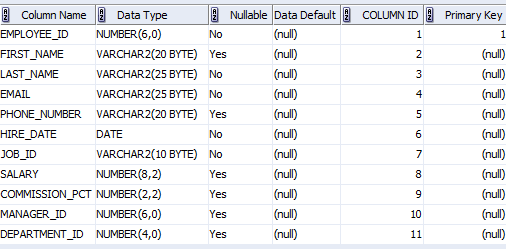Summary: in this tutorial, you will learn about PL/SQL variables that help you manipulate data in PL/SQL programs.
In PL/SQL, a variable is a meaningful name of a temporary storage location that supports a particular data type in a program. Before using a variable, you need to declare it first in the declaration section of a PL/SQL block.
PL/SQL variables naming rules
Like other programming languages, a variable in PL/SQL must follow the naming rules as follows:
- The variable name must be less than 31 characters. Try to make it as meaningful as possible within 31 characters.
- The variable name must begin with an ASCII letter. It can be either lowercase or uppercase. Notice that PL/SQL is case-insensitive, which means
v_dataandV_DATArefer to the same variable. - Followed by the first character are any number, underscore (
_), and dollar sign ($) characters. Once again, do not make your variables hard to read and difficult to understand.
PL/SQL variables naming convention
It is highly recommended that you should follow the naming conventions listed in the following table to make the variables obvious in PL/SQL programs:
| Prefix | Data Type |
|---|---|
| v_ | VARCHAR2 |
| n_ | NUMBER |
| t_ | TABLE |
| r_ | ROW |
| d_ | DATE |
| b_ | BOOLEAN |
Each organization has its own development naming convention guidelines. Make sure that you comply with your organization’s naming convention guidelines.
For example, if you want to declare a variable that holds the first name of the employee with the VARCHAR2 data type, the variable name should be v_first_name.
PL/SQL Variables Declaration
To declare a variable, you use a variable name followed by the data type and terminated by a semicolon ( ;). You can also explicitly add a length constraint to the data type within parentheses. The following illustrates some examples of declaring variables in a PL/SQL anonymous block:
DECLARE
v_first_name varchar2(20);
v_last_name varchar2(20);
n_employee_id number;
d_hire_date date;
BEGIN
NULL;
END;Code language: SQL (Structured Query Language) (sql)PL/SQL variable anchors
In PL/SQL program, one of the most common tasks is to select values from columns in a table into a set of variables. In case the data types of columns of the table changes, you have to change the PL/SQL program to make the types of the variables compatible with the new changes.
PL/SQL provides you with a very useful feature called variable anchors. It refers to the use of the %TYPE keyword to declare a variable with the data type is associated with a column’s data type of a particular column in a table.
Let’s take a look at the employeestable in HRsample database provided by Oracle:
DECLARE
v_first_name EMPLOYEES.FIRST_NAME%TYPE;
v_last_name EMPLOYEES.LAST_NAME%TYPE;
n_employee_id EMPLOYEES.EMPLOYEE_ID%TYPE;
d_hire_date EMPLOYEES.HIRE_DATE%TYPE;
BEGIN
NULL;
END;
/Code language: SQL (Structured Query Language) (sql)The v_first_name variable has a data type that is the same as the data type of the first_namecolumn in the emloyees table. In case the data type of the first_namecolumn changes, the type of the v_first_namevariable automatically inherits the new data type of the column.
PL/SQL variable assignment
In PL/SQL, to assign a value or a variable to another, you use the assignment operator ( := ) which is a colon( :) followed by the equal sign( = ).
Please see the code listing below to get a better understanding:
DECLARE
v_first_name EMPLOYEES.FIRST_NAME%TYPE;
v_last_name EMPLOYEES.LAST_NAME%TYPE;
n_employee_id EMPLOYEES.EMPLOYEE_ID%TYPE;
d_hire_date EMPLOYEES.HIRE_DATE%TYPE;
BEGIN
v_first_name := 'Mary';
v_last_name := 'Jane';
d_hire_date := to_date('19700101','YYYYMMDD');
END;
/Code language: SQL (Structured Query Language) (sql)In the example above, we assigned Mary to v_first_namevariable, Janeto v_last_namevariable, and result of the to_datefunction to d_hire_datevariable.
You can use INTOof the SELECT statement to assign a value to a variable. The INTOclause moves the values from the SELECTquery’s column list into corresponding PL/SQL variables.
SET SERVEROUTPUT ON SIZE 1000000;
DECLARE
v_first_name EMPLOYEES.FIRST_NAME%TYPE;
v_last_name EMPLOYEES.LAST_NAME%TYPE;
n_employee_id EMPLOYEES.EMPLOYEE_ID%TYPE;
d_hire_date EMPLOYEES.HIRE_DATE%TYPE;
BEGIN
SELECT employee_id,
first_name,
last_name,
hire_date
INTO n_employee_id,
v_first_name,
v_last_name,
d_hire_date
FROM employees
WHERE employee_id = 200;
DBMS_OUTPUT.PUT_LINE(v_first_name);
DBMS_OUTPUT.PUT_LINE(v_last_name);
DBMS_OUTPUT.PUT_LINE(d_hire_date);
END;
/Code language: SQL (Structured Query Language) (sql)Initializing variables
When you declare a variable, its value is uninitialized and hence is NULL. You can initialize variable a value in declaration section by using variable assignment.
See the following example:
DECLARE
n_employee_id EMPLOYEES.EMPLOYEE_ID%TYPE :=200;
d_hire_date EMPLOYEES.HIRE_DATE%TYPE:=to_date('19700101','YYYYMMDD');
BEGIN
NULL;
END;
/Code language: SQL (Structured Query Language) (sql)In PL/SQL, NULLmeans an unknown value so it has some special characteristics as follows:
NULLis not equal to anything, even itselfNULL.NULLis not greater than or less than anything else, evenNULL.- You cannot use logical operator equal (
=) or (<>) withNULL. You must use the SQL IS NULL or IS NOT NULL to test the NULL values.
In this tutorial, we have shown you how to declare, assign and initialize PL/SQL variables. We also walked you through how to declare PL/SQL variables using variable anchors to make your code more flexible and adaptable to the changes in columns of the database tables.
